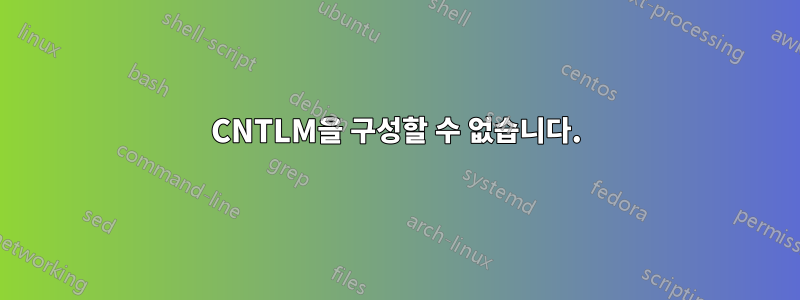
CNTLM을 사용하여 Linux 시스템에 프록시 서버를 설정하고 있습니다. 파일 을 편집 cntlm.conf하고 다음과 같이 변경했습니다.
#
# Cntlm Authentication Proxy Configuration
#
# NOTE: all values are parsed literally, do NOT escape spaces,
# do not quote. Use 0600 perms if you use plaintext password.
#
Username myusername
Password mypasswordinplaintext
# NOTE: Use plaintext password only at your own risk
# Use hashes instead. You can use a "cntlm -M" and "cntlm -H"
# command sequence to get the right config for your environment.
# See cntlm man page
# Example secure config shown below.
# PassLM 1AD35398BE6565DDB5C4EF70C0593492
# PassNT 77B9081511704EE852F94227CF48A793
# # # Only for user 'testuser', domain 'corp-uk'
# PassNTLMv2 D5826E9C665C37C80B53397D5C07BBCB
# Specify the netbios hostname cntlm will send to the parent
# proxies. Normally the value is auto-guessed.
#
# Workstation netbios_hostname
# List of parent proxies to use. More proxies can be defined
# one per line in format <proxy_ip>:<proxy_port>
#
Proxy 192.168.1.107:3128
# List addresses you do not want to pass to parent proxies
# * and ? wildcards can be used
#
NoProxy localhost, 127.0.0.*, 10.*, 192.168.*
# Specify the port cntlm will listen on
# You can bind cntlm to specific interface by specifying
# the appropriate IP address also in format <local_ip>:<local_port>
# Cntlm listens on 127.0.0.1:3128 by default
#
Listen 192.168.34.95:8080
# If you wish to use the SOCKS5 proxy feature as well, uncomment
# the following option. It can be used several times
# to have SOCKS5 on more than one port or on different network
# interfaces (specify explicit source address for that).
#
# WARNING: The service accepts all requests, unless you use
# SOCKS5User and make authentication mandatory. SOCKS5User
# can be used repeatedly for a whole bunch of individual accounts.
#
#SOCKS5Proxy 8010
#SOCKS5User dave:password
# Use -M first to detect the best NTLM settings for your proxy.
# Default is to use the only secure hash, NTLMv2, but it is not
# as available as the older stuff.
#
# This example is the most universal setup known to man, but it
# uses the weakest hash ever. I won't have it's usage on my
# conscience. :) Really, try -M first.
#
#Auth LM
#Flags 0x06820000
# Enable to allow access from other computers
#
#Gateway yes
# Useful in Gateway mode to allow/restrict certain IPs
# Specifiy individual IPs or subnets one rule per line.
#
#Allow 127.0.0.1
#Deny 0/0
# GFI WebMonitor-handling plugin parameters, disabled by default
#
#ISAScannerSize 1024
#ISAScannerAgent Wget/
#ISAScannerAgent APT-HTTP/
#ISAScannerAgent Yum/
# Headers which should be replaced if present in the request
#
#Header User-Agent: Mozilla/4.0 (compatible; MSIE 5.5; Windows 98)
# Tunnels mapping local port to a machine behind the proxy.
# The format is <local_port>:<remote_host>:<remote_port>
#
#Tunnel 11443:remote.com:443
이제 로컬 시스템에서처럼 Firefox의 프록시 설정을 구성할 때마다 192.168.34.95:3128사용자 인증을 요청합니다. 업스트림 프록시에 대한 비밀번호를 인증 파일에 이미 저장했기 때문에 이런 일이 발생해서는 안 됩니다. 방화벽이 비활성화되어 있고 cntlm 로그를 확인하면 다음 메시지가 표시됩니다.
section: global, Username = 'myusername'
section: global, Password = 'passwordinplaintext'
section: global, Proxy = '192.168.1.107:3128'
section: global, NoProxy = 'localhost, 127.0.0.*, 10.*, 192.168.*'
section: global, Listen = '192.168.34.95:8080'
Resolve 192.168.34.95:
-> 192.168.34.95
cntlm: Cannot bind port 8080: Address already in use!
Adding no-proxy for: 'localhost'
Adding no-proxy for: '127.0.0.*'
Adding no-proxy for: '10.*'
Adding no-proxy for: '192.168.*'
cntlm: No proxy service ports were successfully opened.
Exitting with error. Check daemon logs or run with -v.
올바르게 구성 하려면 어떻게 해야 합니까 cntlm?


